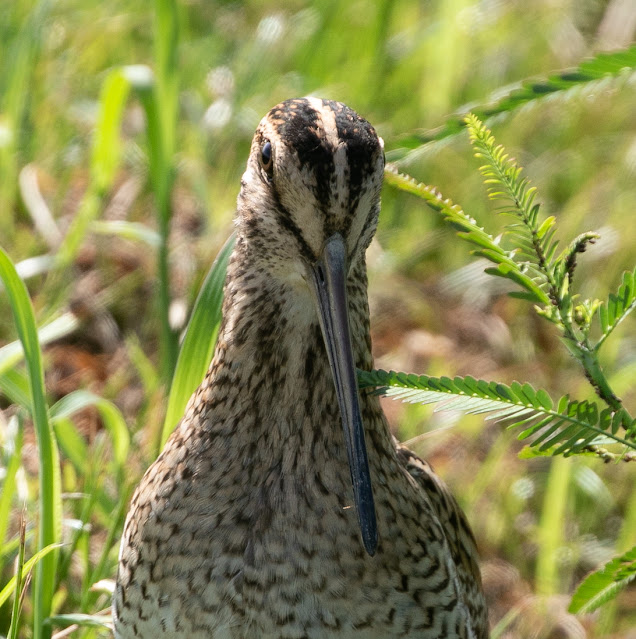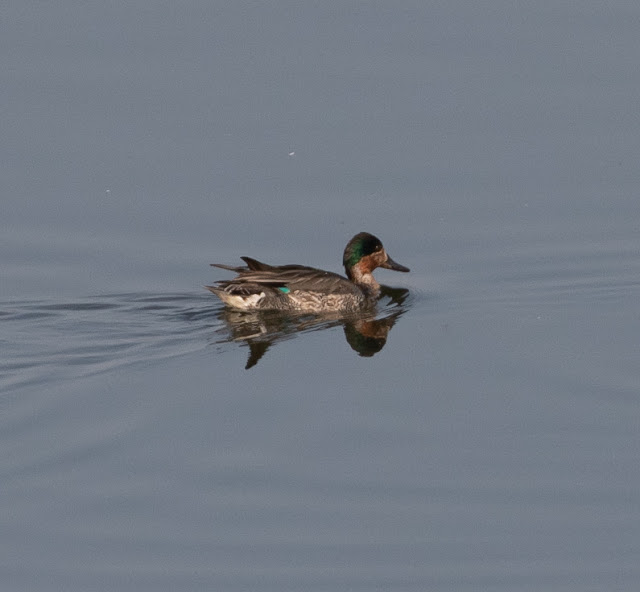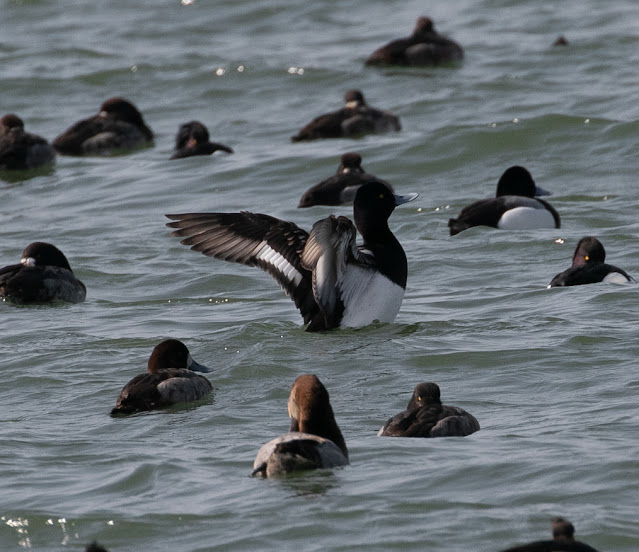I've been trying to see and get more conclusive views of the possible female Lesser Scaup I posted on recently. It's always been a hit and miss bird; would it be present or a no-show today? I'd drawn another blank on a single visit last week and, as things turned out, I didn't find it again yesterday either. Truth be told, I was in two minds whether to give it anymore time, so many hours, so many days..., for inadequate views, inadequate or none at all. For the first time I had no sense of anticipation, no expectation of success driving up the ever busy pre-dawn Route 1. How many rarity-finders reports have I read where the observers had been reduced to this sense of resignation before finally connecting with their difficult bird. Why does it work out for them? As I drove north along the lakeshore I was struck by the low number of ducks out there and when I arrived at the usual stretch there was nothing. I didn't need to pull into any car parks to check, there were simply no aythya out there.
There's a point where you have to give up, right? It was a toss-up; head up to the north end to maybe check the Taigas for a Tundra, I haven't been up there at all this winter(!), or cross the lake and make my way into the hills to look for forest birds for a change. Nearing Biwako Bridge I realized I hadn't switched out the just expired ETC card so that decided it... north end it was. Before long serial roadworks and endless tailbacks put paid to that idea, I wouldn't arrive until late morning at this rate and there's no point spending all daylight in a stop-start line of traffic. I did a little birding near Lake Sainoko then stopped for coffee and a ponder. It was going to take too long to reach the (probably birdless) forest by now as well. Plan D then... look for female Lesser Scaup. So much for the power of coffee if that's all I could come up with.
Why did I bother getting up at 4am? Why not initiate Plan E instead?
Plan E began and ended with go straight home. I was sorely tempted, but as it was a very mild, spring-like day the outre Plan D held the day. At least it wouldn't hurt to drive past the usual spot and see if any ducks had come in, would it? A minor detour.
Approaching, I could see several hundred aythya had come by this time, something to scan through and enjoy the weather. I tripodded the scope, wandered across the grass and used a random duck near one end of the flock to focus. The duck chose that instant to stretch, head forwards out of sight, wing slowly extending sideways till fully displayed. A Lesser Scaup wingbar?!
My heart sank. What?! Scaup can have a Lesser wingbar? Since when? That's ridiculous, what am I even still doing here! As it straightened up the head shape wasn't Greater, the scapulars looked very coarsely vermiculated, almost barred. ...A male Lesser Scaup...?
No, surely not; that would be outrageous - no, it would be inconceivable. Beyond inconceivable, way beyond. This was a random duck I just happened to stick the scope on... and it just happened to stick its wing out and hold that position in that very instant... I spend days in the rain, frigid temperatures, wind, snow, waiting for the glimpse of the other birds wing, a flash, the merest twitch. Words fail me.
After the initial shock and confusion, the next few hours were spent looking at this bird. Or for this bird, it was surprisingly hard to pick-up once lost. Anyway, the upshot is that it really does look very good for a male Lesser Scaup. No obvious hybridization red flags here that I can see.
 |
Head tall, peaked at rear. Bill shallow, black not always visible in profile.
|
 |
| Scapulars with bold or coarse vermiculations, almost barring. Greater Scaup can be very variable with regard to vermiculations and some can look very dark but this is more due to blacker rather than greyer densely pack lines, the overall effect can be similar but the individual lines don't normally look as thick as these broad stripes. The tall, narrow head is clearer when the neck is raised, even slightly like this. |
 |
| Black is restricted to the nail, here just the top visible. Vermiculations clearly visible at a distance where Greater Scaup looks fairly uniform grey. |
 |
| The whole of the nail looks black but I never detected anything off the nail. |
 |
| Another couple of nail shots. |
 |
| This bird was far more obliging than the bird I've been struggling to see the wing pattern on. However, the flock as a whole was restless, heads were often up and some birds were diving, the first time I've seen that in the loafing flocks here. Perhaps their routines are changing pre-departure. |
 |
| Underwing mainly grey but median coverts forming a narrow white bar. Upper primaries grey contrasting sharply with the white secondaries. In these shots the grey p1 is hidden beneath outermost secondary. |
 |
| A hybrid Tufted Duck x Common Pochard or Gt Scaup last week showing underwing (above) and upperwing (below). |
 |
| This particular hybrid was darker and more uniform above than the Tufted x Gt Scaup I've seen. The head is strongly glossed green in direct sun. |
I wondered if the saddle colour might be due to wear or a colour abnormality when I first saw it, it could turn in the water and look every bit as black as the Tufties. I didn't see this bird closely enough to see the actual vermiculations; were they Pochard-fine or Greater-scaup coarse? The overall uniformity suggests the former. The green head sheen was very obvious in direct sun. Does that obviate the Common Pochard option? I've never knowingly seen a Tufted x Pochard hybrid, it would be a hybrid tick!
This winter has been so different to most over the last 20 years. Normally, I'd spent almost all my free time looking at gulls, which seems perfectly reasonable to me, but this winter ducks have really taken centre stage. It's been interesting for sure, due in no small measure to the fascination of hybrids. Strange considering I've no interest, to speak of, in hybrid gulls. That south Biwako is so much closer to home is a huge plus, really easy to back and forth. Will I be back on the lakeshore next week? Well, never say never, but honestly, I seriously doubt it.































































